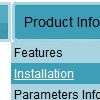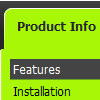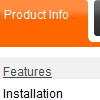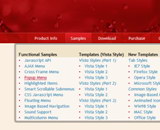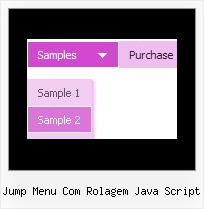Recent Questions
Q: We just bought your product suite including deluxe tabs control. For some reason that the tabs onload is not working in IE 7 only. It works in IE 6 and FF, Chrome and Safari. Attached is the sample page which will show the problem. I also attached our receipt of order for your reference.
Pleae help me to figure out what is the problem with my code ASAP.
A: Try to set exact height for your content DIV. Change height:0%; to height:200px;
<div id="content1" style="height: 200px; visibility: hidden;" class="tabPage">
<div id="content1" style="height:0%; visibility: hidden;" class="tabPage">
Q: When my page loads up, there is a flash for about a second of all the text that is used in the java menus. This looks really bad to visitors like I am using hidden text on the page. Is there a way to prevent this flash of text?
A: I suppose that you see search engine friendly code.
<!-- Code for Deluxe Menu Items. Generated by Deluxe Tuner -->
<div id="dmlinks" style="font:undefined;color:#000000;text-decoration:none">
<a id="dmI0" href="testlink.html">Home</a>
<a id="dmI2" href="testlink.html">Features</a>
...
</div>
<!-- End of Code for Deluxe Menu Items -->
You won't see this text in most cases. We use it on our websites too.
But you can delete this code if you want.
Q: I am currently tasked with creating a large intra-type net for our company. ( knowledge base, FAQ etc. for internal use only ).
At this time I am making plain text or table based menus and getting tired of having to add the drop menus to EVERY page individually in our little intra-web. I would like to purchase software that makes groovy looking menus, but also get the information needed to have them appear on ALL pages after editing the menu once if you know what I mean.
Unfortunately my web authoring experience is best suited to circa-1996 web pages I can hash out in notepad in my sleep. However, I have been told in order to do what I am doing I need to use CSS or styles or cascading stylesheets and not sure if your software will do that.
If I purchase this software and whip up a neat little menu, would you be able to send me information on how to include it in a css as I described above? I would essentially need to know the code or commands to have it appear in all of the pages I create, once I make the menu file. If that is something you can assist me with, I can purchase this right away.
A: Deluxe Menu is Javascript code only. It requires several .js files andit's generated on a client side.
If you don't want to create your drop menus on each page, you can try to useframes, the menu has a cross-frame mode. Also you can use aserver-side script (php, asp, vb, etc.) to generate html pages fromtemplates on your server.
Q: How do I make the background in my rollover drop down menu transparent?
A: You should set the following paramter in your data.js file:
var tmenuBackColor="transeparent";


